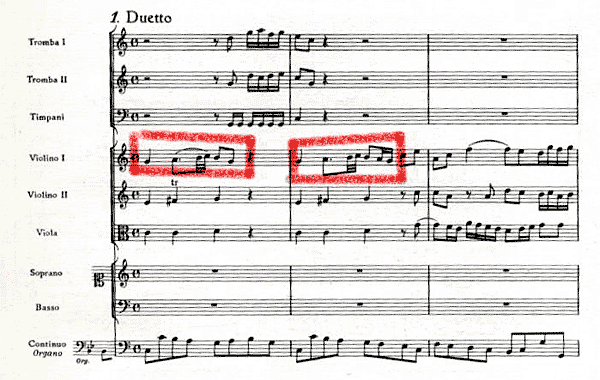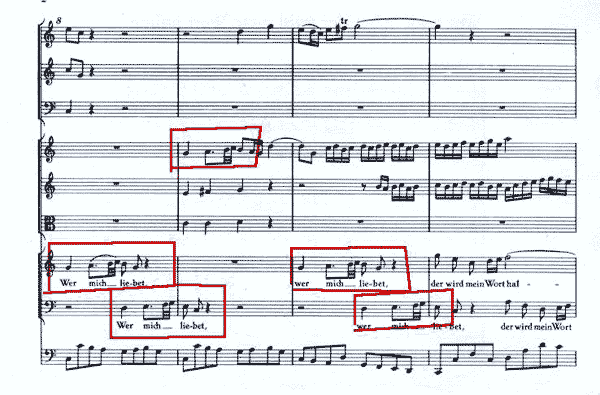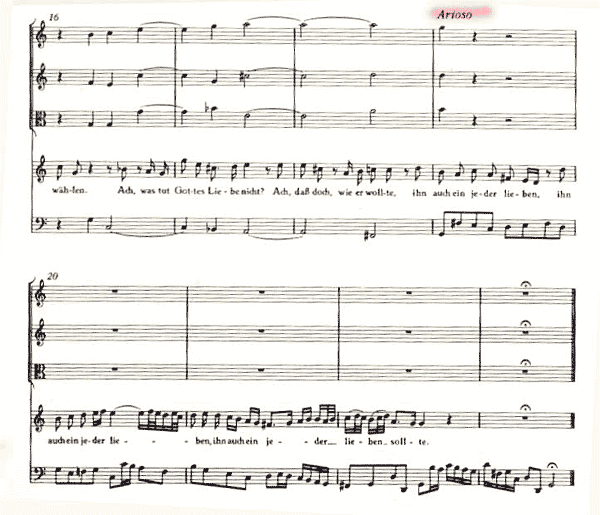Cantata 59 sets a libretto by Erdmann Neumeister (1671-1756). Neumeister was a Saxon-born writer and theologian. He was sort of a “renaissance man” in Bach’s world, serving as an author of libretto texts, a pastor, and a theorist, lecturing on poetry at the University of Leipzig. In 1700, he published Geistliche Cantaten statt einer Kirchen-Music (Sacred Cantatas in Place of Liturgical Music), which consists only of recitatives and ‘operatic’ arias. (Konrad Küster, Oxford Companion to Bach, 314). (Remember that “aria” is sometimes used to mean a soloist or a pair of soloists, rather than a larger ensemble.) Another collection of cantata texts appeared in 1714. In his life, Bach set five of Neumeister’s texts, including the present one, which comes from the 1714 collection. Neumeister wrote seven movements in this text, though Bach set only four. It is not clear whether or not he intended to write additional movements at some time; however, the ending of the score includes the notation that a chorale is to follow, yet there is none provided in the score.
Written for Pentecost Sunday, the words are taken from the Gospel reading (John 14:23). There is some dispute about the dating of this work. Early scholars (including Spitta and C.S. Terry) place the work to when Bach was still in Weimar; more recently, however, scholars have come to place this among Bach’s earliest Leipzig works (Nicholas Anderson,Oxford Companion to Bach, 519), written and performed perhaps even before his position at Thomaskirche was ratified.
Cantata 59 is scored for two vocal soloists (soprano and bass), chorus, two trumpets, timpani, strings, and continuo. The 1723 version reflects the order of movements given by Neumeister, i.e., 1 (Duet), 2 (Recitative), 3 (Chorale), 4 (Aria), but for later revivals (probably from 1724 onwards), the movements were reordered, with the third movement – a setting of the opening strophe of Luther’s 1524 hymn, “Komm, heiliger Geist, Herre Gott”, being placed last, so that the order was not 1-2-3-4. As a result of this reordering, the opening duet for soprano and bass (with full orchestral accompaniment) was followed by a secco recitative for soprano and then by a bass aria with obbligato violin, before the chorale, with its independent orchestral writing, brought the work to its full-toned conclusion.
The first movement is a duet for soprano and bass, accompanied by orchestral strings, continuo, two trumpets, and timpani. The very first motive in the strings, which we hear in the first three beats, becomes the basis for the entire movement. You can see in the excerpt below how it is repeated immediately, with minor ornamentation, in the second measure as well, but listen for this throughout the first movement – you’ll find it in the trumpet, in both voices, and in the strings. Note also the perfect example of a Baroque walking bass line in the continuo part here.

It is a lovely marriage of text and musical motive: “Wer mich liebet, der wird mein Wort halten” (Who loves Me, will keep My word) is the oft-repeated first line of text in this movement, and in the many repetitions of this simple musical motive, the singers and instrumentalists retain the musical motive associated with God’s love and God’s word.

The two voices sing in imitation throughout, until the final statement of “wer mich liebet”, at which point they finally come together in rhythmic unison, but singing in sweet parallel thirds and sixths. The longest purely instrumental passage (ten measures) closes the movement.
The second movement is a recitative for strings, continuo, and soprano solo. Here, we find the first mention of the Holy Spirit, who is the focus of the feast of Pentecost (Whit Sunday). This provides a direct textual link with the subsequent movement, based on the famous Luther chorale “Komm, Heiliger Geist, Herre Gott”. Before jumping to the third movement, however, we need to explore the music of this second movement. It begins as a recitative semplice, with the strings fleshing out the harmonization for the soprano. Five measures from the end, however, Bach indicates arioso, and the upper strings are removed from the texture. Meanwhile, the soprano and continuo lines show significantly more activity, as though filled with the Holy Spirit, leading to the final cadence. The soprano, in fact, leads the continuo, which echoes the descending scale passage moving down a seventh from E to F-sharp – the key pitch in establishing the new tonality, G major.

The third movement sets the first verse of Luther’s hymn. This is a typical four-part chorale setting that we have come to expect at the end of a cantata, not in the middle. The final movement is a short bass aria in a three-part texture – what we might call a trio sonata, using a solo violin, solo bass voice, and continuo. Solo violin parts are relatively uncommon in this first year of Bach’s Leipzig career. The significance of the solo violin is unknown, though clearly the character of the movement is one of joy – joy, perhaps, at the arrival of the Holy Spirit, or perhaps at the anticipation of heavenly bliss to be shared by all the baptized believers someday. The violin does provide a nice contrast to the bass voice, both in terms of timbre and tone, as well as range. Perhaps it is the high range of the violin which Bach values here, linking the earth-bound bass to the heavenly violin.










































